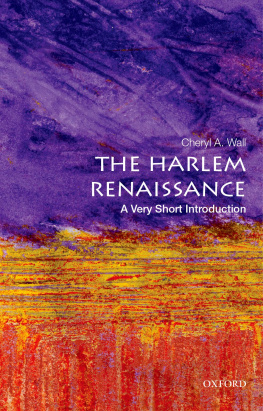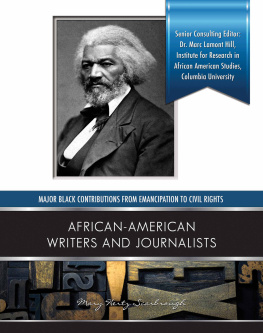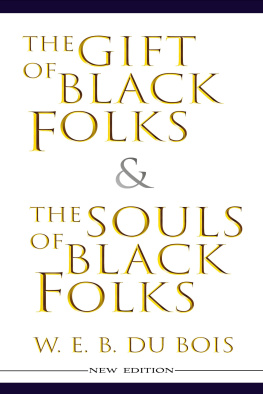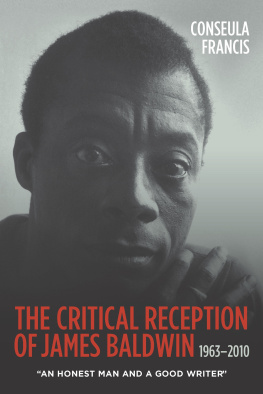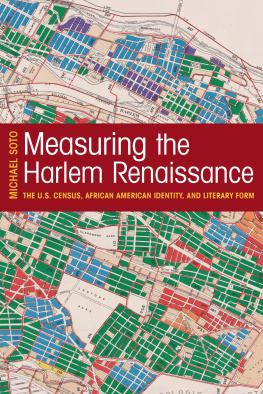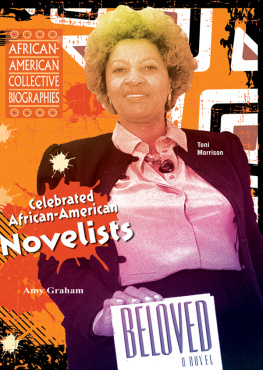Contents
Guide
Pagebreaks of the print version
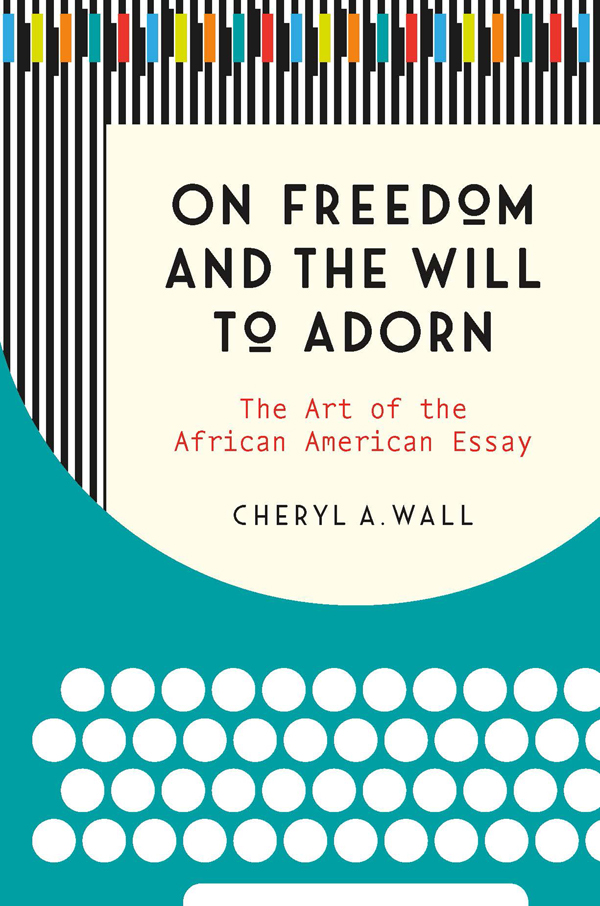
On Freedom and the Will to Adorn
CHERYL A. WALL
On Freedom and the Will to Adorn
The Art of the African American Essay
University of North Carolina Press Chapel Hill
This book was published with the assistance of the Anniversary Fund of the University of North Carolina Press.
2018 Cheryl A. Wall
All rights reserved
Set in Arno by Westchester Publishing Services
Manufactured in the United States of America
The University of North Carolina Press has been a member of the Green Press Initiative since 2003.
Library of Congress Cataloging-in-Publication Data
Names: Wall, Cheryl A., author.
Title: On freedom and the will to adorn : the art of the African American essay / Cheryl A. Wall.
Description: Chapel Hill : University of North Carolina Press, [2018] | Includes bibliographical references and index.
Identifiers: LCCN 2018016245| ISBN 9781469646893 (cloth : alk. paper) | ISBN 9781469646909 (pbk : alk. paper) | ISBN 9781469646916 (ebook)
Subjects: LCSH : African American authorsHistory and criticism. | Essayists, American. | Essay.
Classification: LCC PS 153. N 5 W 328 2018 | DDC 814.009/896073dc23
LC record available at https://lccn.loc.gov/2018016245
Cover illustration by Nathan W. Moehlmann, Goosepen Studio & Press
Portions of chapters 4 and 6 were previously published in a different form. Chapter 4 includes material from Stranger at Home: James Baldwin on What It Means to Be an American, in James Baldwin: America and Beyond , edited by Cora Kaplan and Bill Schwarz (Ann Arbor: University of Michigan Press, 2011), 3552. Chapter 6 includes material from Living by the Word: June Jordan and Alice Walkers Quest for a Redemptive Art and Politics, in Toward an Intellectual History of Black Women , edited by Mia Bay et al. (Chapel Hill: University of North Carolina Press, 2015), 23351. Used here with permission.
For my great-nieces and great-nephew:
Morgan Reid
Marjani Reid
Micah Reid
Mikhel Reid
Contents
Acknowledgments
I have incurred many debts in the process of writing this book. Chief among them is the debt I owe to the graduate and undergraduate students at Rutgers who read essays in my courses, shared their opinions, and questioned mine. They have made this a much better book than it would have been without them. I have tried to discharge my debt to my colleagues mainly by citing their books and articles, but some I need to thank by name. For reading all or part of the manuscript, I thank Ryan Kernan, Douglas Jones, Richard Miller, Stphane Robolin, and Evie Shockley, as well as the anonymous readers at the University of North Carolina Press. I owe a special thank you to Barry Qualls, my most willing and careful reader, who has commented on multiple versions of these pages. I am grateful to Frances Foster for insisting I read writers from the nineteenth century and to Kelly Josephs and Tzarina Prater for giving me confidence enough to write about twenty-first century blogs.
I am grateful to the members of the Towards a Black Womens Intellectual History collective, especially Mia Bay, Farah Jasmine Griffin, Martha Jones, and Barbara Savage, for inviting me to participate in a project that nurtured and challenged my thinking about the essay as a mode of intellectual production for African American women. Over the years that this book has taken shape, I have also benefitted from exchanges with many smart and generous interlocutors, including Elizabeth Alexander, Kathryn Sophia Belle, Daphne Brooks, Thadious Davis, Corinne Field, Douglas Field, Arlette Frund, Jacqueline Goldsby, Mae Henderson, Cora Kaplan, Andre-Anne Kekeh-dika, Dwight McBride, Jocelyn Moody, Brian Norman, Bill Schwarz, Hortense Spillers, Justine Talley, Mary Helen Washington, Deborah White, and Andra Williams.
For their sharp questions and insightful comments, I thank audiences at Barnard College, Case Western Reserve University, Cleveland State University, the Caribbean Philosophical Association, the Collegium for African American Research Conference at Universit de Paris Diderot, the Collegium of Black Women Philosophers, Emory University, New York University, Northwestern University, Oklahoma City University, Queen Mary University in London, Rutgers University, Universidad de La Laguna in Tenerife, Spain, Universit de Paris VIII, Vincennes-St. Denis, the University of Michigan, Vanderbilt University, and Yale University.
For brilliant conversations and technical expertise, I thank my graduate assistants Brian Becker, Gabrielle Everett, Ariel Martino, Amadi Ozier, Beth Perry, Elliott Souder, and especially Tasia Milton. I thank as well the archivists who assisted me with the research for this project, especially Randall Burkett at the Manuscripts and Research Library at Emory, Steven Fullwood and Miranda Mims at the Schomburg Center for Research in Black Culture, Marilyn Morgan at the Schlesinger Library, and the staff of the Library of Congress.
For permission to reprint previously published material, I thank the University of Michigan Press and the University of North Carolina Press.
This is my second experience working with the editors at the University of North Carolina Press, and I am grateful for the always incisive advice of Mark Simpson-Vos. I am also appreciative of the contributions of Dino Battista, Kristen Bettcher, Iris Oakes, and Jessica Newman. Finally, everything I do depends on the love and encouragement of my family. My daughter Camara and sister Gatsie are my biggest fans. I am blessed that my niece Monique and her husband Paul share their wonderful children with me. It is my joy to dedicate this book to Morgan, Marjani, Micah, and Mikhel Reid.
On Freedom and the Will to Adorn
Prologue
Moving from the Margins
Writing at the Margins , the subtitle of a collection of Toni Morrisons nonfiction, captures exactly the status of the essay in literary studies in general and African American literary studies in particular. The aim of this book is to move consideration of the African American essay from the margins to the center.
What is an essay? Readers and critics agree that it is much easier to say what an essay is not, rather than what it is. It is not a philosophical treatise, although it may be the site of philosophical reflection. It is not a systematic argument, although it may make a case for a particular position. It is not reportage, although it may recount events. It is not autobiography, although it may tell parts of the authors life. An essay is not a letter, though some essays that are written for publication assume the guise of private correspondence. James Baldwins Letter to My Nephew is one example; Ta-Nehisi Coatess Between the World and Me , putatively addressed to his son, is another. In looking for an affirmative definition, critics may agree that rather than exhausting a subject, the essayist works around and through a specific aspect of it, prompted usually by a particular and often personal encounter with its implications. The hybridity of the form makes it capacious enough to incorporate other genresshort stories, literary and political critique, and memoir. If the formal criteria are vague, the opportunities the form affords are not. The essay offers its creator intellectual freedomthe freedom to work around, with, and through an idea. It is, as its name denotes, a trial or an attempt.
In large part because it is perceived as occasional writing, the essay has achieved little critical currency. Even its practitioners describe the genre in belittling terms: dispersed meditations, fragments of my deceits, and free association artistically controlled are representative. Perhaps he did so to signal that the eight previously published pieces were extensively revised, but his decision may reveal some doubt he harbored about the seriousness of the essay form. Many critics have expressed similar doubts.


